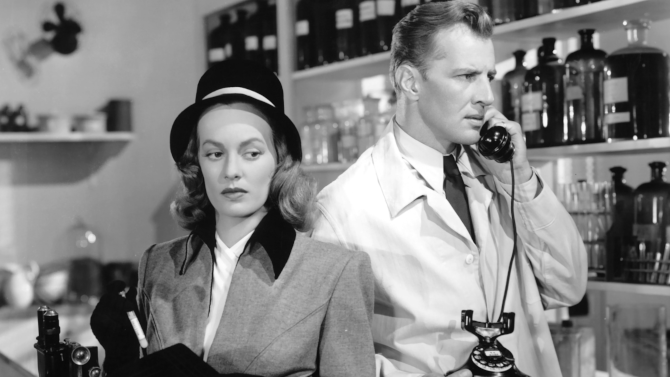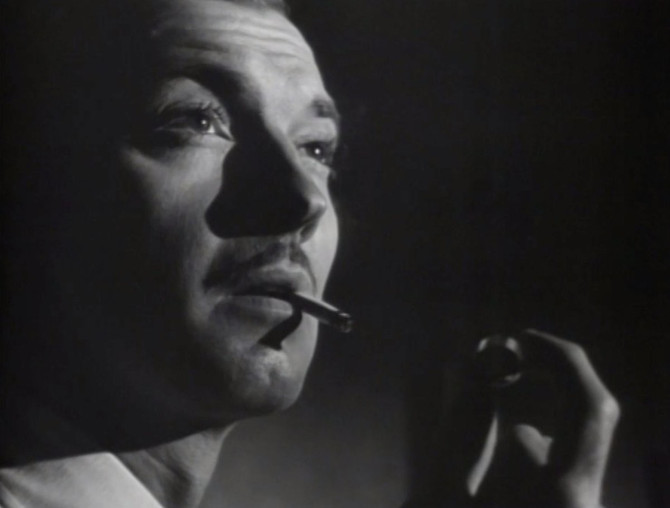A young woman’s cold dead body lays on a bed – an apparent suicide (there is a note); a man taking the wedding ring off her hand, then stealing money from her purse; he hops out of the window with his luggage, tweaking his leg in the process. . . this is the dark and intoxicating opening to 1945’s Danger Signal, directed by Robert Florey.
Based upon a novel of the same name by Phyllis Bottome, the above mentioned man is Ronnie Mason (Zachary Scott), he’s as smooth as silk, as silken as velvet, as velvety as velour. . . in other words, he’s a slick chameleon bluebeard that women should be wary of (but never are).
Limping into another optimal scenario, Hilda Fenchurch (Faye Emerson), a stenographer who isn’t exactly beating men off with a stick, is taking down a sign her mother (Mary Servoss) has put up to attract a new billet for their empty room. . . she doesn’t feel they need the hassle. Seeing her removing the sign, this sly supposed author talks her into renting it to him – the snake charmer quickly winning over both mother and daughter.
Soon, he’s dating the love starved Hilda, much to the chagrin of a doctor she works with, Andrew Lang (Bruce Bennett) – a shy bumbler and all-round good guy. Yet, things don’t get any simpler, as Hilda’s younger sister, Anne (Mona Freeman), returns home – better looking and coming into a rather sizable inheritance upon her marriage. . . talk about a tease for a Machiavellian character.
Finding himself in a love/hate triangle, Anne is all over the attention giving man. . . ignoring her much younger suitor, Bunkie (Richard Erdman), while Hilda, starting to understand this man’s true nature, turns her attention to breaking up the pair. But how low will she stoop? Could things turn deadly?
Opening with one of the great intros in film noir history while building solid characters throughout the piece (it helps that the actors are spot on), Danger Signal is another example of a B movie transcending its budget. Paired with fantastic visuals – the off-kilter Dutch angle is used early on to give Ronnie a dangerous feel, while shadow and silhouette (thanks to cinematographer James Wong Howe) get to the essence of this dark individual, everything comes together to make for an alluring affair. And intriguingly, the closest thing to a femme fatale in this is, in fact, Ronnie – a male gigolo of sorts who draws lonely women in, only to lead them to death or destruction. The script is flipped in other ways as well, as you’ve got strong women trying to stop him. . . on top of the persistent Hilda, her psychologist work friend, Dr. Silla (Rosemary DeCamp), also tries to get to the root of the motivations of this sinister fella.
Sadly, the ending was changed due to two things – one, The Hays Office, and two, the fact Faye Emerson was engaged and then married (during production) to President Franklin D. Roosevelt’s son, Colonel Elliott Roosevelt, and Warner Bros. feared that she could not be involved in any kind of murder – as it would be box office poison. Akin to leading a Formula One race for ninety-nine percent of it and then driving off a cliff at the very end, it is the only thing that detracts from this film noir – and you can easily imagine how this picture should have concluded (looking to the original book can also help).
With a classic dramatic crime story, some less than subtle commentary on male and female relationships, intriguing visuals as well as stellar performances, and despite its lackluster ending, Danger Signal is still a most worthwhile film noir that plays with genre tropes and often transcends them. So, enjoy this classic motion picture, and don’t fear – there’s no chance of a cliffhanger.



